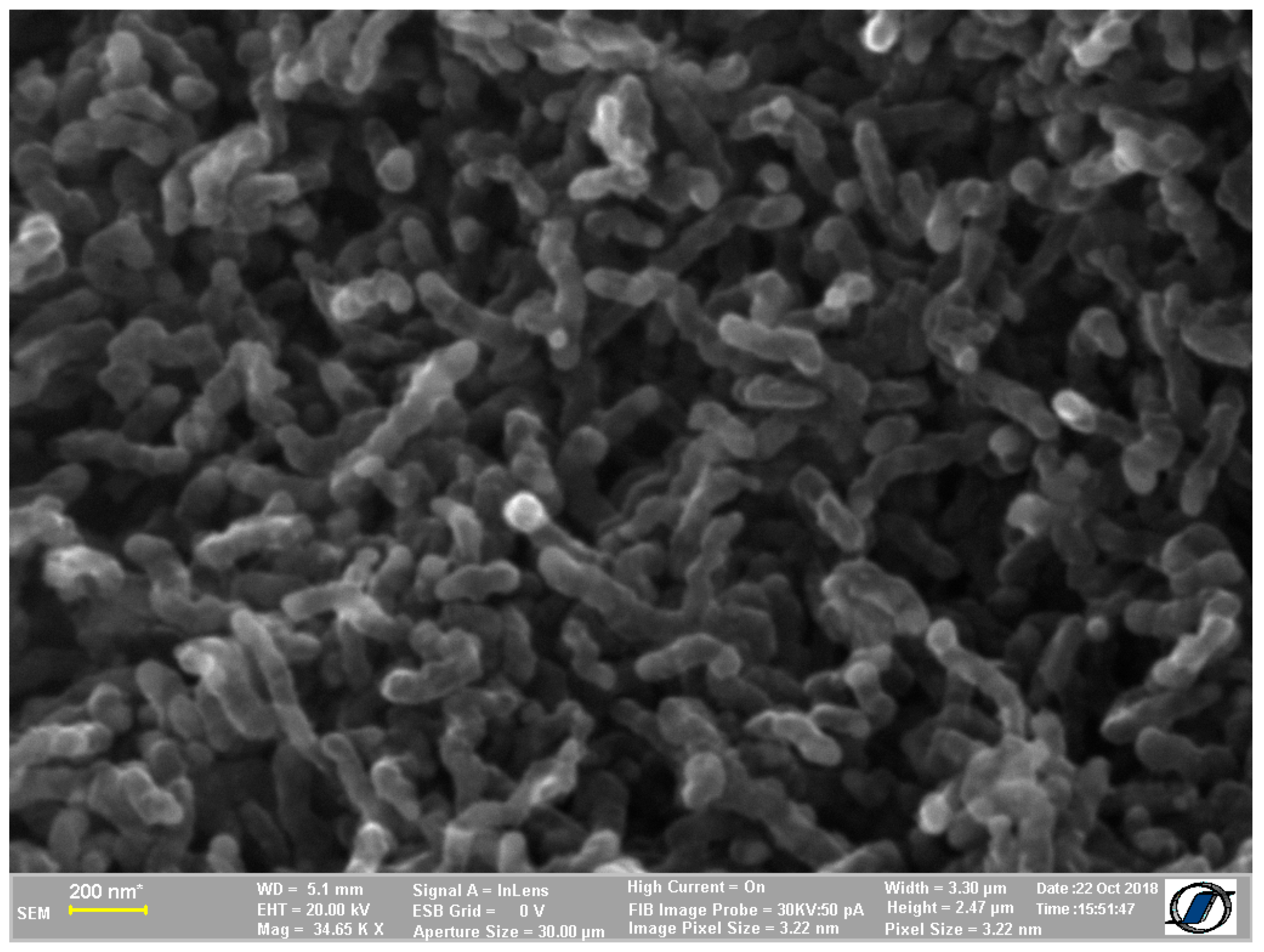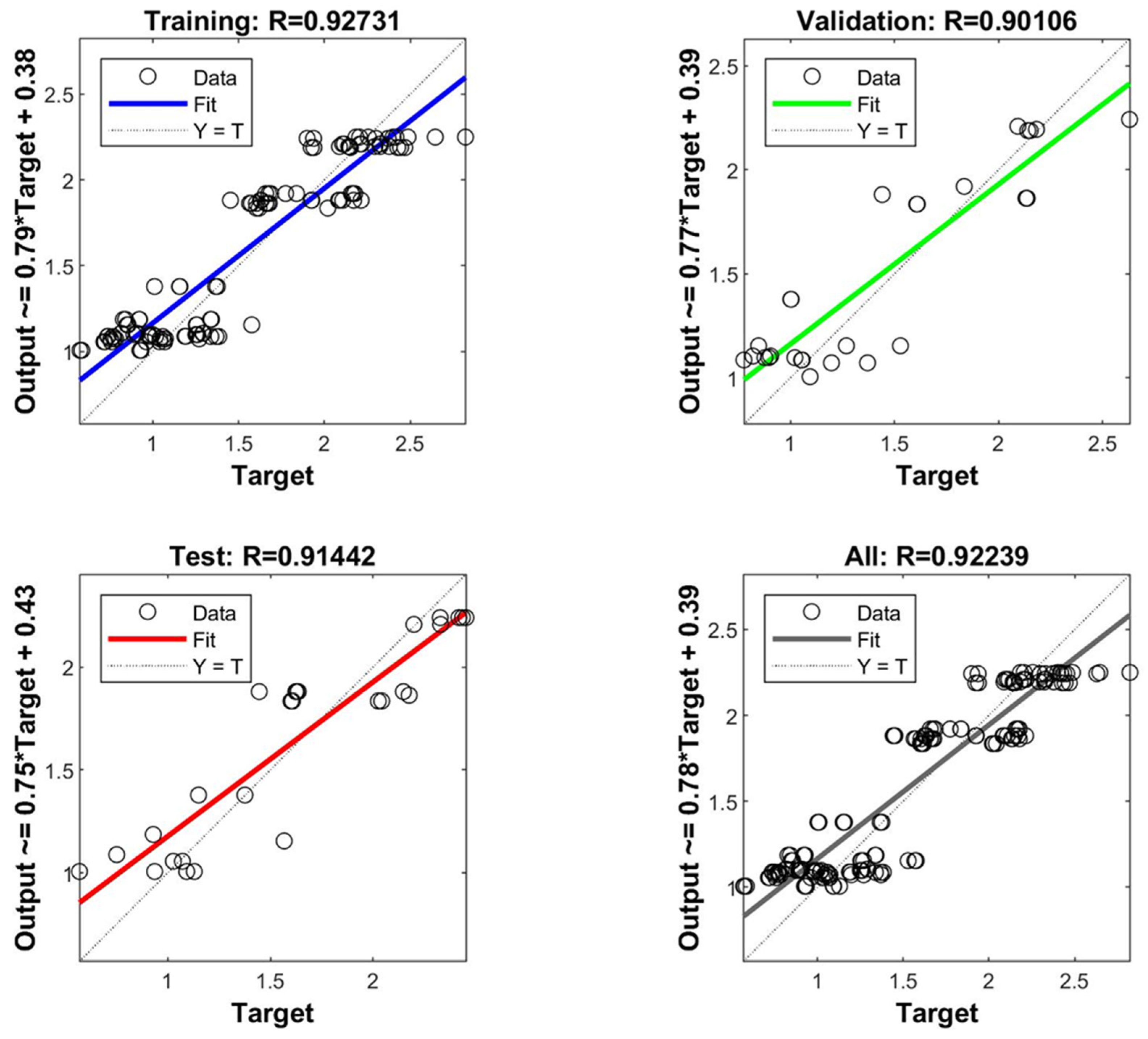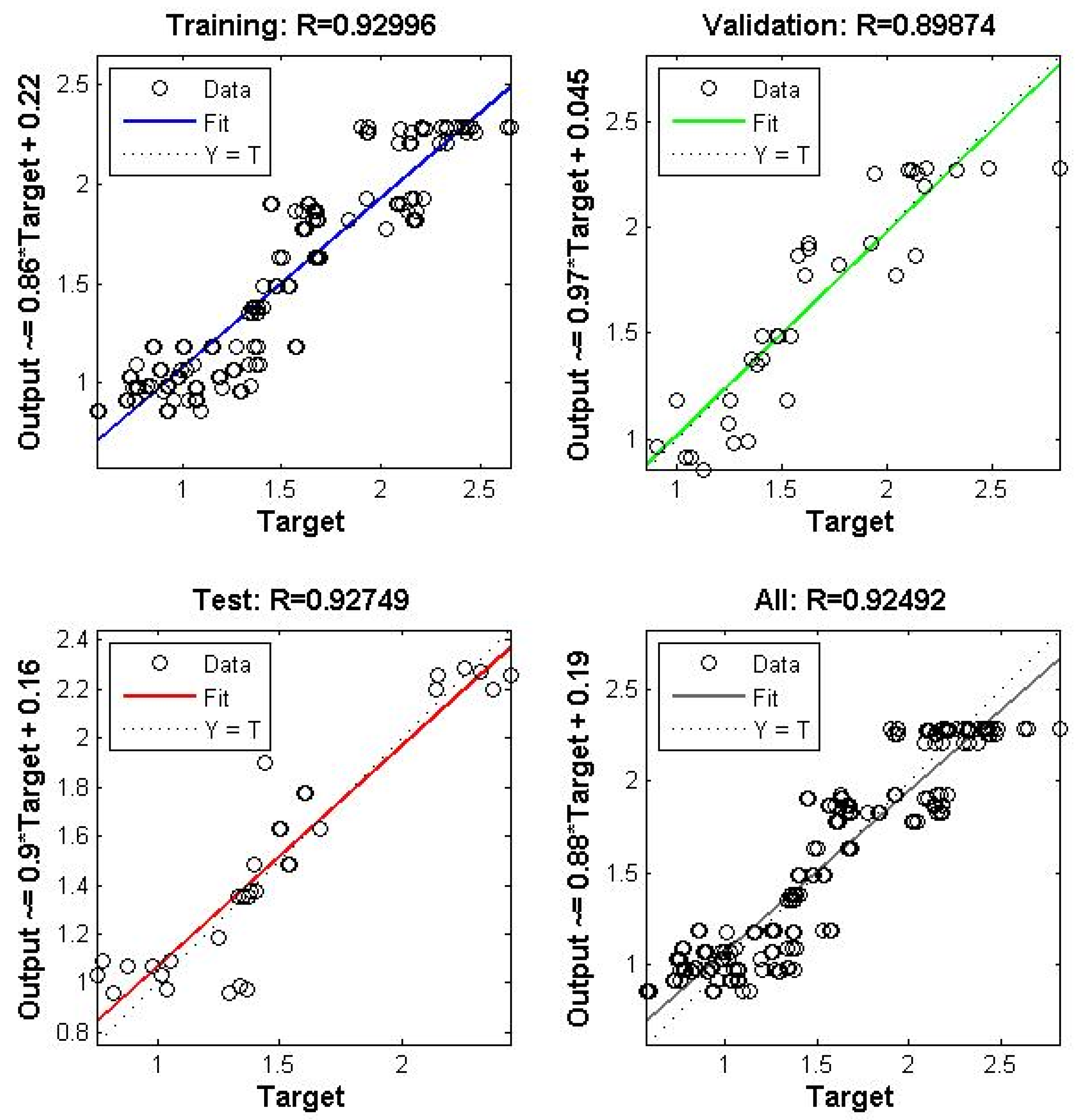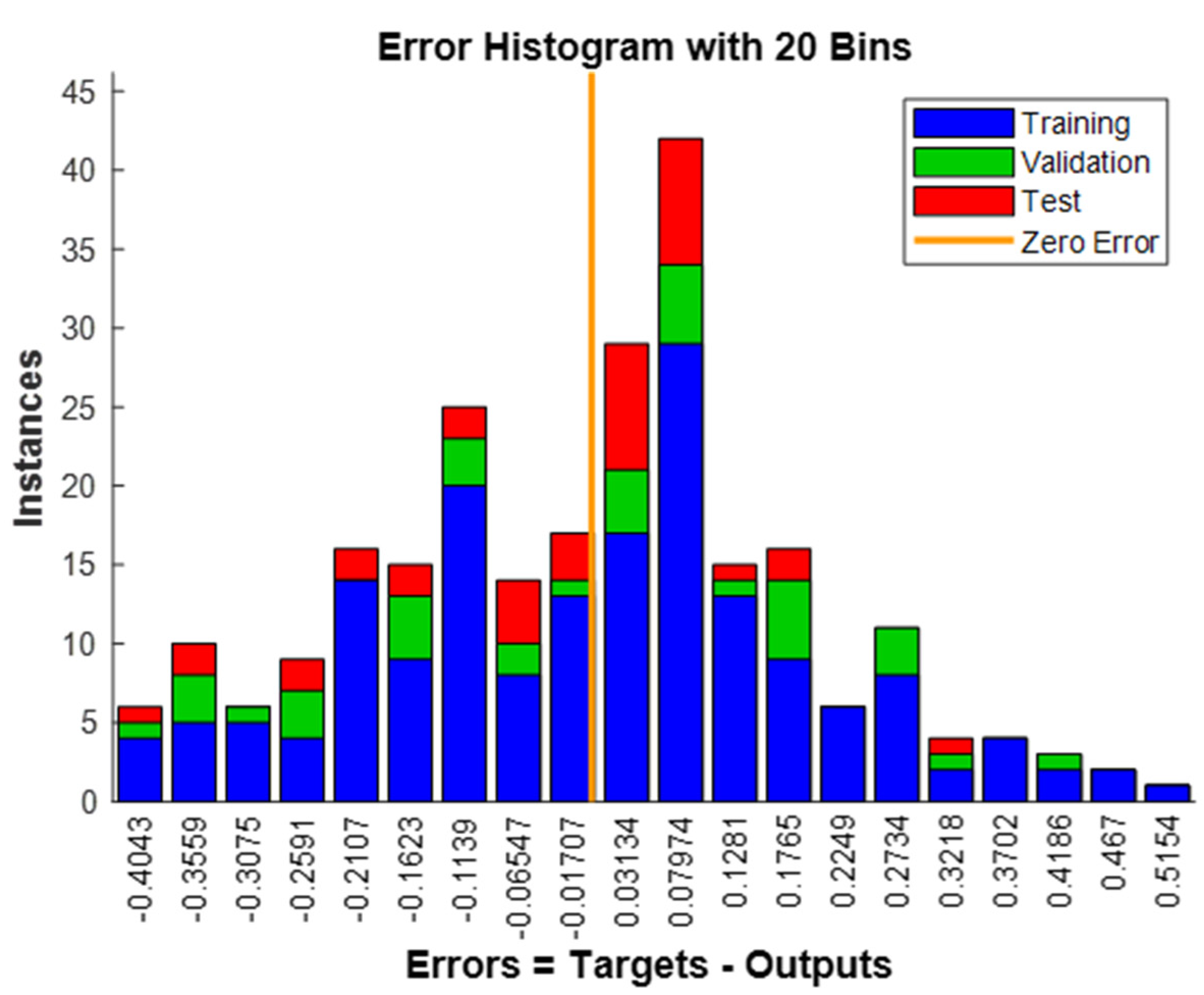Influence of a Novel Carbon-Based Nano-Material on the Thermal Conductivity of Mortar
Abstract
:1. Introduction
2. Materials and Methods
2.1. Materials
2.2. Methods
3. Results
3.1. Density
3.2. Thermal Conductivity (λ)
3.3. Thermal Conductivity (λ) Using Artificial Neural Network
4. Discussion
5. Conclusions
- The use of a novel carbon-based nano-material leads to higher initial values of thermal conductivity compared to the reference mix, even at very low percentages of 0.025%wt of cement. The carbon-based nano-material was added to the mortar mix without the use of surfactants or sonication procedure. The low scattering of the experimental results between the samples of the same mix is a good indicator of the uniform spreading of the CBN inside the mortar, especially for lower percentages. The highest benefit in terms of the values for thermal conductivity is obtained for the mix with a CBN content of 0.05%wt of cement. A higher percentage leads to a significant drop in terms of thermal conductivity. This may be attributed to the bundling effect, which should be investigated by means of SEM during the next stage of the research.
- The change in storage conditions for the mortar samples leads to a drop in the values of thermal conductivity. The slowing down of the chemical reaction due to cement hydration coupled with evaporation of water from capillaries results in a 23–27% drop in the values of thermal conductivity for mixes with 0.025% and 0.05% CBNs. However, the thermal conductivity of the reference mix and of the mix with 0.1% CBN continues to increase.
- A backpropagation artificial neural network with a Levenberg-Marquardt BP algorithm has been developed and is used to predict the values of the thermal conductivity. Very good predictions are made for 28 and 35 days. The change in storage conditions impacts the accuracy of the ANN and initial predictions differ by 20–30%, in some cases being underestimated and in other cases being overestimated. Retraining the ANN improves the accuracy, and only a 5% relative error is obtained for the curing ages of 100 and 140 days, irrespective of mortar mix, owing also to a significantly larger number of data sets. The ANN proves to be an efficient tool for running long term predictions on the evolution of material characteristics as long as accurate data is used for the training stage. However, in view of the future developments of the ANN to include other input parameters, additional methods will be used for cross-checking the accuracy of the predicted results, such as the Hashin–Schtrikman bounds and the Eshelby model.
- Further research is deemed necessary in the direction of developing reliable predictions in terms of the thermal conductivity of cement-based construction materials incorporating either “traditional” nano-materials or newly developed nano-materials. The underlying phenomena that lead to the trends observed during the experimental program, e.g., the mix with a higher percentage of CBN exhibiting lower values of thermal conductivity, should be better understood and explained by using SEM and XRD analyses.
- The use of CBNs may prove useful, especially at early ages, because the obtained mortar exhibits high values of thermal conductivity. This would ensure a more rapid dissipation of the hydration heat and may represent an alternative method to mitigate early cracking due to thermal stresses. Even at later ages, such as 140 days, the use of CBN in 0.05%wt of cement still manages to yield a 18.4% higher value of thermal conductivity compared to the reference mix. These higher values of thermal conductivity may prove advantageous in case of fire hazards as it would help dissipate the heat over a much wider area and, therefore, decrease the local temperature and prevent degradations in terms of load bearing capacity of the elements. In normal, day-to-day applications, the benefit is, however, in significant increases in the values of the mechanical properties, as reported in the scientific literature for MWCNTs. The main advantage of the new CBN relies on the fact that it does not need surfactants to prevent coalescence, and neither does it need sonication to ensure uniform dispersion prior to mixing. Further in-depth investigations will be conducted to provide additional information in this direction.
Author Contributions
Funding
Institutional Review Board Statement
Informed Consent Statement
Data Availability Statement
Conflicts of Interest
References
- Gamal, H.A.; El-Feky, M.S.; Alharbi, Y.R.; Abadel, A.A.; Kohail, M. Enhancement of the Concrete Durability with Hybrid Nano Materials. Sustainability 2021, 13, 1373. [Google Scholar] [CrossRef]
- Nadiv, R.; Shtein, M.; Refaeli, M.; Peled, A.; Regev, O. The critical role of nanotube shape in cement composites. Cem. Concr. Compos. 2016, 71, 166–174. [Google Scholar] [CrossRef]
- Karakouzian, M.; Farhangi, V.; Farani, M.R.; Joshaghani, A.; Zadehmohamad, M.; Ahmadzadeh, M. Mechanical characteristics of cement paste in the presence of carbon nanotubes and silica oxide nanoparticles: An experimental study. Materials 2021, 14, 1347. [Google Scholar] [CrossRef] [PubMed]
- Song, H.; Li, X. An Overview on the Rheology, Mechanical Properties, Durability, 3D Printing, and Microstructural Performance of Nanomaterials in Cementitious Composites. Materials 2021, 14, 2950. [Google Scholar] [CrossRef]
- Qader, H.A.; Jasim, A.M.; Salim, H.; Xing, Y. Enhanced Mechanical and Durability Properties of Cement Mortar by Using Alumina Nanocoating on Carbon Nanofibers. Materials 2022, 15, 2768. [Google Scholar] [CrossRef]
- Neto, J.D.; Santos, T.A.; De Andrade Pinto, S.; Dias, C.M.; Ribeiro, D.V. Effect of the combined use of carbon nanotubes (CNT) and metakaolin on the properties of cementitious matrices. Constr. Build. Mater. 2021, 271, 121903. [Google Scholar] [CrossRef]
- Lee, H.S.; Balasubramanian, B.; Gopalakrishna, G.V.T.; Kwon, S.-J.; Karthick, S.P.; Saraswathy, V. Durability performance of CNT and nanosilica admixed cement mortar. Constr. Build. Mater. 2018, 159, 463–472. [Google Scholar] [CrossRef]
- Siddique, R.; Mehta, A. Effect of carbon nanotubes on properties of cement mortars. Constr. Build. Mater. 2014, 50, 116–129. [Google Scholar] [CrossRef]
- Bautista-Gutierrez, K.P.; Herrera-May, A.L.; Santamaría-López, J.M.; Honorato-Moreno, A.; Zamora-Castro, S.A. Recent progress in nanomaterials for modern concrete infrastructure: Advantages and challenges. Materials 2019, 12, 3548. [Google Scholar] [CrossRef] [Green Version]
- Saleem, H.; Zaidi, S.J.; Alnuaimi, N.A. Recent advancements in the nanomaterial application in concrete and its ecological impact. Materials 2021, 14, 6387. [Google Scholar] [CrossRef]
- Biercuk, M.J.; Llaguno, M.C.; Radosavljevic, M.; Hyun, J.K.; Johnson, A.T.; Fischer, J.E. Carbon nanotube composites for thermal management. Appl. Phys. Lett. 2002, 80, 2767–2769. [Google Scholar] [CrossRef]
- Kumari, L.; Zhang, T.; Du, G.; Li, W.; Wang, Q.; Datye, A.; Wu, K. Thermal properties of CNT-Alumina nanocomposites. Compos. Sci. Technol. 2008, 68, 2178–2183. [Google Scholar] [CrossRef]
- Lee, H.; Song, Y.M.; Loh, K.J.; Chung, W. Thermal response characterization and comparison of carbon nanotube-enhanced cementitious composites. Compos. Struct. 2018, 202, 1042–1050. [Google Scholar] [CrossRef] [Green Version]
- Hassanzadeh-Aghdam, M.K.; Mahmoodi, M.J.; Safi, M. Effect of adding carbon nanotubes on the thermal conductivity of steel fiber-reinforced concrete. Compos. Part B Eng. 2019, 174, 106972. [Google Scholar] [CrossRef]
- Petrella, A.; De Gisi, S.; Di Clemente, M.E.; Todaro, F.; Ayr, U.; Liuzzi, S.; Dobiszewska, M.; Notarnicola, M. Experimental Investigation on Environmentally Sustainable Cement Composites Based on Wheat Straw and Perlite. Materials 2022, 15, 453. [Google Scholar] [CrossRef]
- Al-Mughanam, T.; Aldhyani, T.H.H.; Alsubari, B.; Al-Yaari, M. Modeling of compressive strength of sustainable self-compacting concrete incorporating treated palm oil fuel ash using artificial neural network. Sustainability 2020, 12, 9322. [Google Scholar] [CrossRef]
- Huang, X.; Zhang, J.; Sresakoolchai, J.; Kaewunruen, S. Machine learning aided design and prediction of environmentally friendly rubberised concrete. Sustainability 2021, 13, 1691. [Google Scholar] [CrossRef]
- Roshani, M.M.; Kargar, S.H.; Farhangi, V.; Karakouzian, M. Predicting the effect of fly ash on concrete’s mechanical properties by ANN. Sustainability 2021, 13, 1469. [Google Scholar] [CrossRef]
- Dantas, A.T.A.; Batista Leite, M.; De Jesus Nagahama, K. Prediction of compressive strength of concrete containing construction and demolition waste using artificial neural networks. Constr. Build. Mater. 2013, 38, 717–722. [Google Scholar] [CrossRef]
- El-Sayed, A.A.; Fathy, I.N.; Tayeh, B.A.; Almeshal, I. Using artificial neural networks for predicting mechanical and radiation shielding properties of different nano-concretes exposed to elevated temperature. Constr. Build. Mater. 2022, 324, 126663. [Google Scholar] [CrossRef]
- SR EN 197-1:2011; Cement-Part I: Composition, Specifications and Conformity Criteria for Normal Use Cements. European Committee for Standardization: Brussels, Belgium, 2011.
- Inoue, Y.; Kakihata, K.; Hirono, Y.; Horie, T.; Ishida, A.; Mimura, H. One-step grown aligned bulk carbon nanotubes by chloride mediated chemical vapor deposition. Appl. Phys. Lett. 2008, 92, 213113. [Google Scholar] [CrossRef] [Green Version]
- Madni, I.; Hwang, C.-Y.; Park, S.-D.; Choa, Y.-H.; Kim, H.-T. Mixed surfactant system for stable suspension of multiwalled carbon nanotubes. Colloids Surf. A Physicochem. Eng. Asp. 2010, 358, 101–107. [Google Scholar] [CrossRef]
- Torabian Isfahani, F.; Li, W.; Redaelli, E. Dispersion of multi-walled carbon nanotubes and its effects on the properties of cement composites. Cem. Concr. Compos. 2016, 74, 154–163. [Google Scholar] [CrossRef]
- Xu, S.; Liu, J.; Li, Q. Mechanical properties and microstructure of multi-walled carbon nanotube-reinforced cement paste. Constr. Build. Mater. 2015, 76, 16–23. [Google Scholar] [CrossRef]
- Morsy, M.S.; Alsayed, S.H.; Aqel, M. Hybrid effect of carbon nanotube and nano-clay on physico-mechanical properties of cement mortar. Constr. Build. Mater. 2011, 25, 145–149. [Google Scholar] [CrossRef]
- ASTM D5334-14; Standard Test Method for Determination of Thermal Conductivity of Soil and Soft Rock by Thermal Needle Probe Procedure. ASTM International: West Conshohocken, PA, USA, 2014.
- Felix, E.F.; Possan, E.; Carrazedo, R. A New Formulation to Estimate the Elastic Modulus of Recycled Concrete Based on Regression and ANN. Sustainability 2021, 13, 8561. [Google Scholar] [CrossRef]
- Maqsoom, A.; Aslam, B.; Gul, M.E.; Ullah, F.; Kouzani, A.Z.; Mahmud, M.A.P.; Nawaz, A. Using Multivariate Regression and ANN Models to Predict Properties of Concrete Cured under Hot Weather. Sustainability 2021, 13, 10164. [Google Scholar] [CrossRef]
- Ye, Z.; Kim, M.K. Predicting electricity consumption in a building using an optimized back-propagation and Levenberg–Marquardt back-propagation neural network: Case study of a shopping mall in China. Sustain. Cities Soc. 2018, 42, 176–183. [Google Scholar] [CrossRef]
- Liu, K.; Wang, Z.; Jin, C.; Wang, F.; Lu, X. An experimental study on thermal conductivity of iron ore sand cement mortar. Constr. Build. Mater. 2015, 101, 932–941. [Google Scholar] [CrossRef]
- Shafigh, P.; Asadi, I.; Akhiani, A.R.; Mahyuddin, N.B.; Hashemi, M. Thermal properties of cement mortar with different mix proportions. Mater. Construcción 2020, 70, 224. [Google Scholar] [CrossRef]
- Leyton-Vergara, M.; Pérez-Fargallo, A.; Pulido-Arcas, J.; Cárdenas-Triviño, G.; Piggot-Navarrete, J. Influence of Granulometry on Thermal and Mechanical Properties of Cement Mortars Containing Expanded Perlite as a Lightweight Aggregate. Materials 2019, 12, 4013. [Google Scholar] [CrossRef] [PubMed] [Green Version]
- Tetko, I.V.; Villa, A.E.P. An Enhancement of Generalization Ability in Cascade Correlation Algorithm by Avoidance of Overfitting/Overtraining Problem. Neural Process. Lett. 1997, 6, 43–50. [Google Scholar] [CrossRef]
- Francioso, V.; Moro, C.; Velay-Lizancos, M. Effect of recycled concrete aggregate (RCA) on mortar’s thermal conductivity susceptibility to variations of moisture content and ambient temperature. J. Build. Eng. 2021, 43, 103208. [Google Scholar] [CrossRef]
- Alafogianni, P.; Dassios, K.; Tsakiroglou, C.D.; Matikas, T.E.; Barkoula, N.M. Effect of CNT addition and dispersive agents on the transport properties and microstructure of cement mortars. Constr. Build. Mater. 2019, 197, 251–261. [Google Scholar] [CrossRef]
- Li, Y.; Li, H.; Jin, C. Effect of multi-walled carbon nanotubes on the damping property of cement mortar and mechanism analysis. Arch. Civ. Mech. Eng. 2021, 21, 102. [Google Scholar] [CrossRef]
- Gomes, M.G.; Flores-Colen, I.; Manga, L.M.; Soares, A.; De Brito, J. The influence of moisture content on the thermal conductivity of external thermal mortars. Constr. Build. Mater. 2017, 135, 279–286. [Google Scholar] [CrossRef]
- Dai, J.; Wang, Q.; Bi, R.; Wang, C.; Han, Z.; Du, W.; Chen, Z. Research on influencing factors and time-varying model of thermal conductivity of concrete at early age. Constr. Build. Mater. 2022, 315, 125638. [Google Scholar] [CrossRef]









| Mix Designation | Cement [g] | Sand [g] | Water/Cement | CBN/Cement [%] |
|---|---|---|---|---|
| REF | 500 | 2050 | 0.6 | - |
| CBN-025 | 0.025 | |||
| CBN-05 | 0.05 | |||
| CBN-1 | 0.1 |
| Mix Designation | Curing Age (Days) | ||||||
|---|---|---|---|---|---|---|---|
| 7 | 14 | 21 | 28 | 35 | 100 | 140 | |
| REF | 0.87 ± 0.23 | 0.94 ± 0.16 | 1.04 ± 0.23 | 0.97 ± 0.19 | 1.06 ± 0.26 | 1.36 ± 0.02 | 1.35 ± 0.01 |
| CBN-025 | 1.75 ± 0.21 | 1.88 ± 0.22 | 1.80 ± 0.27 | 1.72 ± 0.29 | 1.91 ± 0.24 | 1.47 ± 0.06 | 1.47 ± 0.05 |
| CBN-05 | 2.21 ± 0.1 | 2.43 ± 0.22 | 2.31 ± 0.24 | 2.18 ± 0.22 | 2.20 ± 0.1 | 1.62 ± 0.09 | 1.60 ± 0.07 |
| CBN-1 | 1.05 ± 0.16 | 1.01 ± 0.22 | 1.03 ± 0.23 | 1.18 ± 0.16 | 1.22 ± 0.31 | 1.38 ± 0.02 | 1.39 ± 0.02 |
| Curing Age (Days) | R2 | MSE |
|---|---|---|
| 28 | 0.93275 | 0.0434 |
| 35 | 0.92239 | 0.0464 |
| 100 | 0.92492 | 0.0434 |
Publisher’s Note: MDPI stays neutral with regard to jurisdictional claims in published maps and institutional affiliations. |
© 2022 by the authors. Licensee MDPI, Basel, Switzerland. This article is an open access article distributed under the terms and conditions of the Creative Commons Attribution (CC BY) license (https://creativecommons.org/licenses/by/4.0/).
Share and Cite
Alexa-Stratulat, S.-M.; Covatariu, D.; Toma, A.-M.; Rotaru, A.; Covatariu, G.; Toma, I.-O. Influence of a Novel Carbon-Based Nano-Material on the Thermal Conductivity of Mortar. Sustainability 2022, 14, 8189. https://doi.org/10.3390/su14138189
Alexa-Stratulat S-M, Covatariu D, Toma A-M, Rotaru A, Covatariu G, Toma I-O. Influence of a Novel Carbon-Based Nano-Material on the Thermal Conductivity of Mortar. Sustainability. 2022; 14(13):8189. https://doi.org/10.3390/su14138189
Chicago/Turabian StyleAlexa-Stratulat, Sergiu-Mihai, Daniel Covatariu, Ana-Maria Toma, Ancuta Rotaru, Gabriela Covatariu, and Ionut-Ovidiu Toma. 2022. "Influence of a Novel Carbon-Based Nano-Material on the Thermal Conductivity of Mortar" Sustainability 14, no. 13: 8189. https://doi.org/10.3390/su14138189







